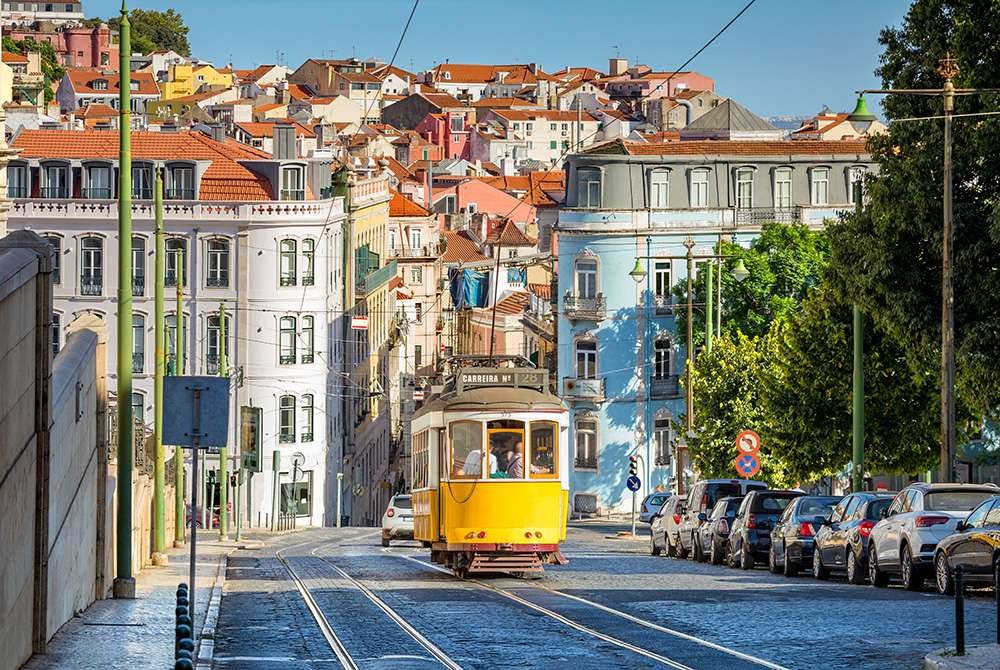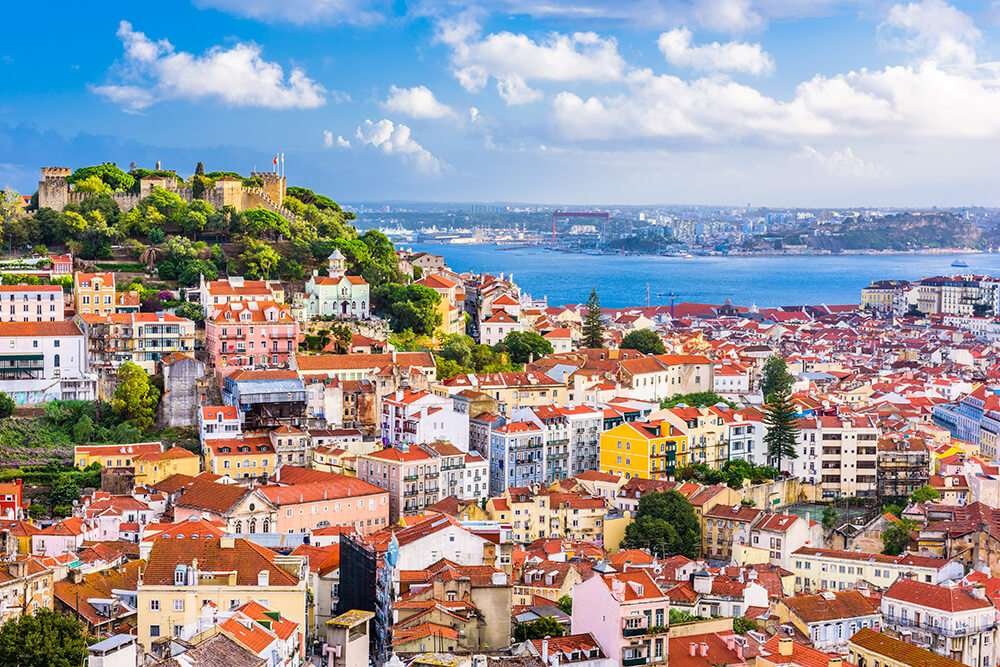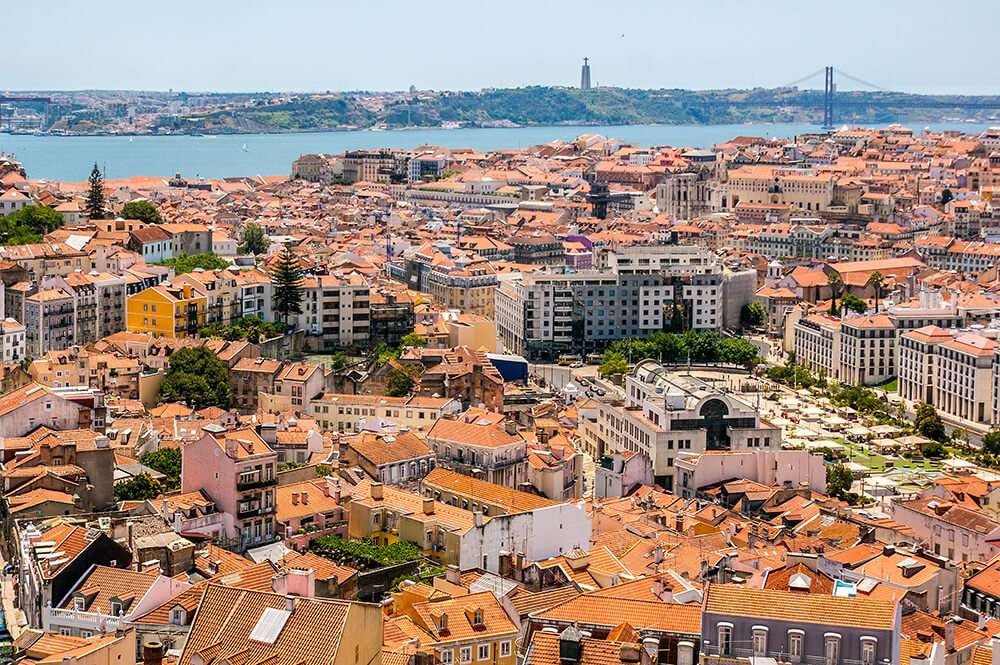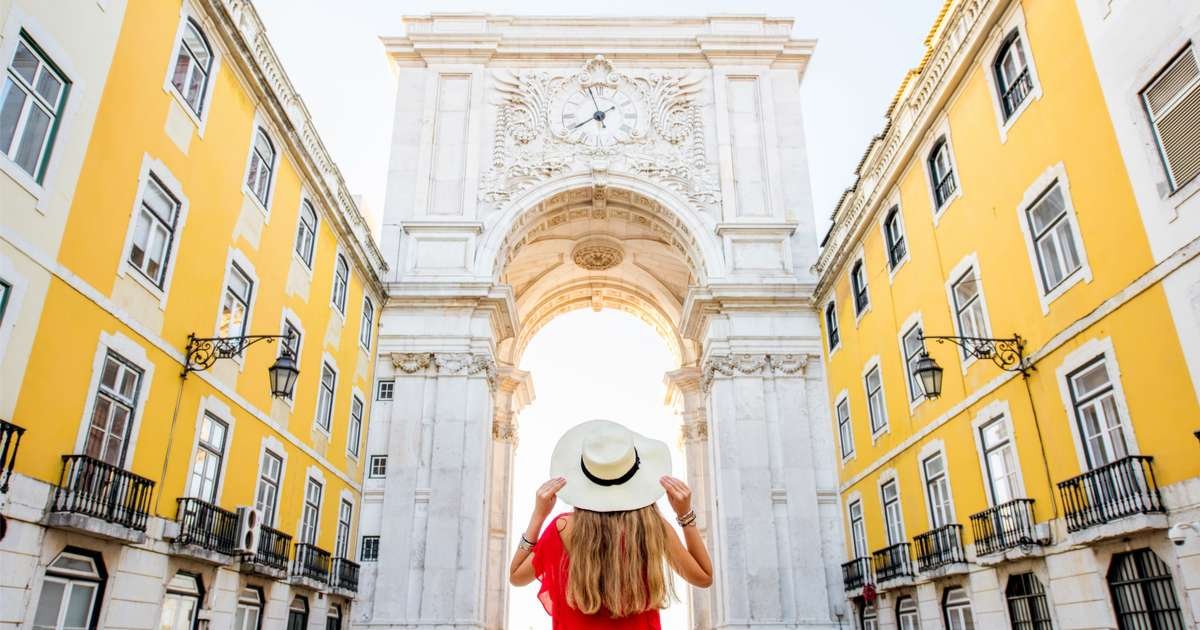Get ready to discover the best of Portugal’s capital- the shining and romantic Lisbon.
One of Europe’s oldest cities, Lisbon beautifully intertwines her historic past with the new and modern developments, which often sit side by side on the patterned stone avenues.
Lisbon is a city with districts rich in character and unique flavors and with three days to discover the center, historic quarters and cultural riverside, we know you’ll leave with your appetite satisfied.
The Three Days in Lisbon itinerary is packed with entertainment and will keep your days busy. If you want to see all the sights we’ve included, you’re more than welcome, but be sure to put on your comfiest pair of walking shoes.
On the other hand, if you want to adventure at a pace compatible with the Portuguese lifestyle, take your time, enjoy long meals and skip the locations that don’t interest you. You will still leave Lisbon with a wonderful idea of Portuguese culture and history, even if you don’t do it all.
And for those who really want the total experience, head over to our 50 Things to Do in Lisbon Guide!
Other Recommended Articles:
Public Transportation in Lisbon
Recommended Hotels in Lisbon
Things to Do with Kids in Lisbon
Best Restaurants in Lisbon
Shopping in Lisbon

Getting Around
Lisbon is one of the most pedestrian friendly cities as its small and most major sites are easily reachable. We suggest walking as much as possible to enjoy the azulejos up close, peek down the tiny narrow side streets and admire the window fronts full of handmade crafts Lisbon is home to.
For the sights not within walking distance we’ve included a few tips on how to use Lisbon's public transportation- which is affordable and runs often. The Viva Viagem Card is the required pass for public transportation and can be reloaded as needed. For those who want to do and see a lot, this saves time and money.
- Recommendation: Lisboa Card 50+ attractions + Public transport
Day One in Lisbon: Historical Day in Alfama
Where better to start than in the heart of the historic quarter? Alfama is the oldest neighborhood in Lisbon and offers a glimpse into how the city began and how far back her roots stretch (spoiler alert, the Romans were here).

Top 10 Sights in and Around Alfama
1. At the very base of the hilly Alfama is Praça do Comércio. This grand plaza is the gateway to Lisbon and prior to the devastating earthquake of 1755, it was the site of the Royal Palace.
2. The unmissable Rua Augusta Arch is a commemorative piece to celebrate the new city that rose from the rubble post earthquake. You can take an elevator to the top of Rua Augusta Arch and gain an incredible view of the downtown area.
3. There are many places to sit and dine in the square but the oldest is the haunt of Lisbon’s literature circle, the Café Martinho da Arcada.
Following the tram tracks uphill will lead you directly to Alfama’s front door. The tram cars run through the center of Alfama and most of the big sights are more or less along the way. At any point you can catch the Tram 28E at one of the stations, but as the neighborhood is dense with things to see, we advise walking. If you do hop onboard, get ready to step back in time as the interior has been maintained to resemble the authentic designs and the ride is as full of jolts and halting stops as it was almost 100 years ago.
4. We suggest you first stop at the Lisbon Cathedral (Se Cathedral), striking with its large rose window and gothic towers. Like many structures in Lisbon, it suffered damage from the earthquake and required restoration, resulting in a fantastic combination of architectural styles. It’s free to enter and inside are artifacts found in the courtyard, believed to be more than 2000 years old.
5. The next site is São Jorge Castle, a historic citadel established in 200 B.C. Crowning the top of the highest point in Alfama, it offers fantastic views and is a great attraction for families traveling to Lisbon.
6. After São Jorge Castle, head to Santa Luzia Miradouro. Here you will discover a terrace with one of the most stunning views in the city.
7. Beside the miradouro is the bougainvillea-covered Church of Santa Luzia that is listed as a national monument and complete with azulejo historic murals.
8. One of the highlights is that many Alfama restaurants offer traditional Fado performances with dinner. If learning more about Fado interests you, visit the Fado Museum and experience the music that captures the heartache of the Portuguese.
9. Stick to the route led by the tram tracks just a bit further and you’ll be at the Palácio Azurara. One of Alfama’s top museums, it displays different examples of Portuguese decorative art from the 15th to 19th centuries.
10. Directly across from the Palácio Azurara is the Portas do Sol Miradouro. This area is sought-out for postcard worthy photographs as it includes a great shot of the Monastery of São Vicente de Fora. Standing beside one of the most popular kiosks in Lisbon is the patron saint of Lisbon, Saint Vincent, who has been honored in statue form. We suggest using this point to relax and sip on a chilled glass of fruity sangria. It’s common for street musicians to gather here and perform for those who know how to appreciate the slow pace of life in Lisbon.
Popular Ticket Options for Alfama:
- Lisbon: History, Stories and Lifestyle Walking Tour
- Best of Lisbon Walking Tour: Rossio, Chiado & Alfama
- Lisbon: Alfama Tour and Live Fado with Traditional Dinner (Recommended)
- Lisbon: National Pantheon E-Ticket & Audio City Tour
- Segway Medieval Guided Tour of Alfama
- Ticket overview for São Jorge Castle
- Combo: 24-hour hop-on hop-off tour of Lisbon + tickets to St. George's Castle
- Ticket for Lisbon Cathedral (Sé de Lisboa)

Alfama's Artsy Neighbor, Graça.
As you continue through the winding roads of Alfama, you will slowly enter the neighboring district of Graça. Get ready to hike straight up, because you can’t reach it without a bit of a climb. Graça is more residential than Alfama, which means restaurants are cheaper and the shops are less touristy. This area is ideal for those who enjoy street art and murals. Two of the most famous works we would recommend seeing are by Shepard Fairey and Vhils.
Highlights of Graça.
1. At the very peak of Graça you will discover the Graça Miradouro with a cafe that is always buzzing with customers. The viewpoint from Graça offers visitors a chance to see São Jorge Castle, the patterned streets of Baixa, point out the peeping dome of Estrela Basilica and admire the 25 de Abril Bridge. You’ll often find artists here working under the shade of the pine trees, each trying to capture the enchanting magic of Lisbon.
2. Beside the miradouro is the Igreja da Graça, originally constructed in the 13th century. One of the oldest churches in Lisbon, Igreja da Graça offers visitors the chance to admire gilded chapels and ornate baroque details.
3. At the end of the day, pop into Tejo Bar, a great local spot that generally has live music; a joint where regulars serve their own drinks and where you are sure to find a small and intimate crowd which stretches into the early hours of the morning.
Graça is becoming a hot spot for new pop up cafes and some of Lisbon's best vegetarian and vegan restaurants.

Day Two in Lisbon: The Post-Earthquake Pombaline Style Center
The second day of the itinerary focuses on the central area of the city and its closest neighborhoods. The Baixa neighborhood is mostly low and flat and here you will discover wide boulevards which open up into grand plazas with neoclassical style shopping and dining establishments. Popular with tourists, this area was rebuilt under the direction of Marques de Pombal, earning the nickname of Baixa Pombalina.
Top 20 Not-To-Be-Missed Highlights
1. Begin the day at the now familiar, Rua Augusta Arch which leads directly into the popular pedestrian-only shopping street by the same name. Shopping, restaurants, hotels, boutiques, pastelarias and bars all line the calçada portuguesa (black and white patterned) street of Rua Augusta.
2. Make your way past window fronts full of clothing, souvenirs and pastries until arriving at the world’s oldest bookstore, the Bertrand Livraria. Its doors opened in 1732 and have welcomed curious readers since. It once served as a meeting spot for many of Portugal’s most famous literary minds but now mostly caters to those looking to take home a new book.
3. As you continue up Rua Augusta, on the right you will pass the gothic elevator, the Santa Justa Lift. Skip the slow and long line to ride to the top and instead directly visit the viewing deck which is free to access. There is a hidden elevator inside the Cork Shop on Rua do Carmo, which takes you to the street above. From there you can access the deck of the Santa Justa Lift.
4. There are some nice restaurants and bars in this area which offer places to relax with a view. And if you like rooftops, make sure to check out our complete list of the best rooftops in Lisbon when planning your trip! In a city with more viewpoints than you can count, finding the location that's right for you is truly spectacular.
5. From the top of the Santa Justa Lift take the path to Carmo Convent. Once the largest church in Lisbon, it was destroyed by the earthquake and only the skeleton structure remains. Head inside to discover the convent and the Carmo Archeological Museum which includes art, beautiful tile murals and even a few mummies.
6. In the neighborhood streets of Chiado you will find upscale boutiques, theaters and luxury shopping opportunities.
7. If you’re in search of a fresh cup of coffee, pop into the early 20th century Brasileira Café. Famous for being a past favorite of the Portuguese poet Fernando Pessoa, he is now honored out front with a bronze statue.
8. Just a bit past Carmo Convent you will find Rossio Square down below, which greets gazers with a wave-like patterned floor and the magnificent neo-manueline style train station located on the left. At the palace-like Rossio Station trains depart regularly to Sintra if you’re interested in taking a day trip.
9. Another old favorite with the literary personalities of Portuguese culture is Café Nicola, an 18th century art deco style cafe. Grab a chair and have a pastry here and if you picked up a book at Bertrand Livraria, take a break from all the walking.
10. If you’re ready to continue we suggest stopping at A Ginjinha at the top of the square. Here you can order a shot of the traditional cherry liqueur, ginjinha, at Lisbon’s oldest bar.
11. Rossio flows smoothly into Restauradores Square, which combines classical 17th century architecture and art deco buildings with ornate façades.
12. Notable buildings here are the pink Palacio Foz, which was the equivalent of Portugal’s Palace Versailles when it was built in the 18th century and the famous once-silent film theater, Eden.
13. And of course, not to be missed is the Gloria Funicular which runs up the hill to the lively Bairro Alto.
14. Connected to Restauradores Square is Avenida de Liberdade, the beautiful tree- lined boulevard with large pedestrian paths which run alongside some of the most expensive real estate in the city. To many, it resembles the famous boulevard in Paris, Champs-Elysées.
15. Crowning the avenue is the Praça Marquês de Pombal, a large roundabout with a statue honoring the man who reinvisioned the rebuilding of Lisbon and her agriculture, politics and education.
16. Past the rotunda is the green sloping hillside of Eduardo VII Park.
17. Walking paths lead to a viewpoint at the top and beside the park is the Estufa Fria, three wonderful connected greenhouses which feature plants from different climates.
18. For those who enjoy art, a visit to the Calouste Gulbenkian Museum is a must. The tremendous collection encompasses cultures from around the world. Take a stroll through the Gulbenkian Gardens and admire the landscaping and small lake.
19. Finish a full day of touring with a night out in the Cais do Sodré neighborhood.
20. Located only minutes from the main coastal train station and Time Out Market, you can bar hop and enjoy decently priced drinks on Pink Street. This lively bar area with bubble gum pink floors is a popular photo destination as well as a thriving nightlife corner.

Day Three in Lisbon: The Cultural Riverside District of Belém
For day three we have planned a trip to the neighboring district of Belém. To reach Belém we suggest using the most convenient form of public transportation which would be the coastal train. Head to Cais do Sodré train station and buy a one way ticket to the Belém station.
The 10 Best Attractions in Belém
2. Follow the riverside walkway until you reach Belém Tower, the most symbolic of all of the monuments in Lisbon. The defense post turned UNESCO World Heritage Site at the mouth of the Tagus marks the location where ships embarked and disembarked.
3. On the opposite side of the street from the river is the Berardo Collection Museum, located within the grand Belém Cultural Center. This museum houses an extensive collection of contemporary and modern art by the big name artists.
4. The next recommended stop is the Jerónimos Monastery. Another UNESCO World Heritage Site, the monastery honors Vasco da Gama, the Portuguese explorer to complete the first journey to India. It’s a not-to-be-missed attraction and we suggest braving the lines to tour it.
5. After you exit the Jerónimos Monastery, only a short walk away is the Tropical Botanical Garden established to preserve rare plants. The Botanical Garden was showcased in the 1940 Portuguese World Fair to exhibit what the country had acquired from past colonies.
6. As you exit the gardens you enter the small historic town of Belém. It’s only a single street but has many options for lunch. The most popular bakery in the whole country, Pastéis de Belém, is located here. Established in 1837, it is said that this bakery holds the one true recipe for pastel de nata.
7. The next museum is the National Coach Museum, with an extensive collection of lavish horse drawn carriages which once belonged to either royals or high ranking figures.
8. After finishing with the museums, we suggest walking back along the riverside. The large pedestrian path, feet from the Tagus river, rewards with a view of the bridge and the Cristo Rei. Standing at more than 100 meters tall, you can easily spot it from just about anywhere.
9. Along the way, stop at the Museum of Art, Architecture and Technology which offers an ideal location to take a photo. The MAAT is a world class work of architecture with engaging exhibitions within. The rooftop has a giant deck where people come for sunset to enjoy the picturesque view before them.
10. End the day at LX Factory, Lisbon’s creative hub. Transformed from an alternative creative center run by artists during the economic crises of the early 2000s, it is now a major tourist destination and trendy place to work and socialize. It’s full of bars, cafes and restaurants. Have a short tour through the stores and art studios before sitting down, resting your legs and enjoying a tasty meal.
Popular Ticket Options for Belém:
- Popular ticket options for a Lisbon River Cruise
- Combo: Monument to the Discoveries + Belém Tower Tickets
- Popular tickets for the Belém Tower
- Ticket Overview for Jerónimos Monastery
- Classic Lisbon Combo: Sao Jorge Castle + Belém Tower + Jerónimos Monastery Tickets
Congratulations! You have successfully completed your 3-day itinerary in Lisbon. Now, you have seen all the main things and discovered enough history to guide your friends and family through the city next time!
If you are spending more time in Lisbon, definitely check out our list of 50 Things to Do In Lisbon and discover what else you would enjoy about the city. Be sure to tell us what your favorite part of this 3-day trip in Lisbon was in the comments below!

